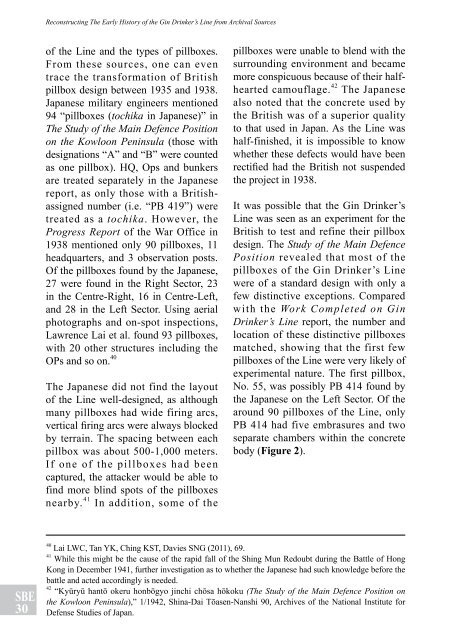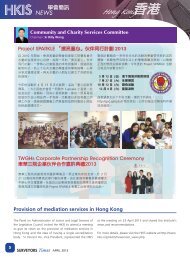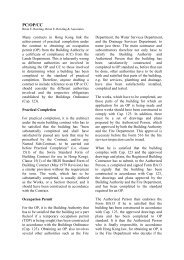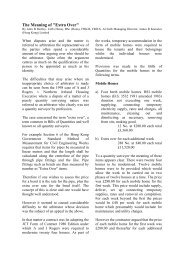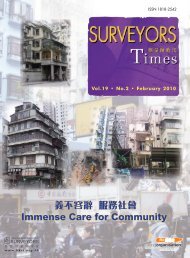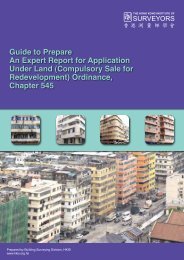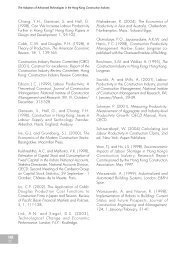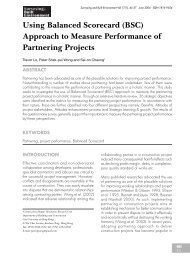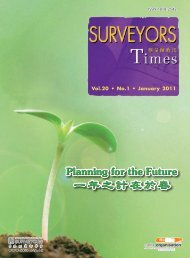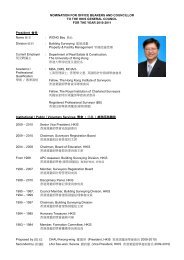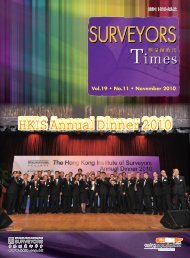Surveying & Built Environment Vol. 22 Issue 1 (December 2012)
Surveying & Built Environment Vol. 22 Issue 1 (December 2012)
Surveying & Built Environment Vol. 22 Issue 1 (December 2012)
Create successful ePaper yourself
Turn your PDF publications into a flip-book with our unique Google optimized e-Paper software.
SBE<br />
30<br />
Reconstructing The Early History of the Gin Drinker’s Line from Archival Sources<br />
of the Line and the types of pillboxes.<br />
From these sources, one can even<br />
trace the transformation of British<br />
pillbox design between 1935 and 1938.<br />
Japanese military engineers mentioned<br />
94 “pillboxes (tochika in Japanese)” in<br />
The Study of the Main Defence Position<br />
on the Kowloon Peninsula (those with<br />
designations “A” and “B” were counted<br />
as one pillbox). HQ, Ops and bunkers<br />
are treated separately in the Japanese<br />
report, as only those with a Britishassigned<br />
number (i.e. “PB 419”) were<br />
treated as a tochika. However, the<br />
Progress Report of the War Office in<br />
1938 mentioned only 90 pillboxes, 11<br />
headquarters, and 3 observation posts.<br />
Of the pillboxes found by the Japanese,<br />
27 were found in the Right Sector, 23<br />
in the Centre-Right, 16 in Centre-Left,<br />
and 28 in the Left Sector. Using aerial<br />
photographs and on-spot inspections,<br />
Lawrence Lai et al. found 93 pillboxes,<br />
with 20 other structures including the<br />
OPs and so on. 40<br />
The Japanese did not find the layout<br />
of the Line well-designed, as although<br />
many pillboxes had wide firing arcs,<br />
vertical firing arcs were always blocked<br />
by terrain. The spacing between each<br />
pillbox was about 500-1,000 meters.<br />
If one of the pillboxes had been<br />
captured, the attacker would be able to<br />
find more blind spots of the pillboxes<br />
nearby. 41 In addition, some of the<br />
pillboxes were unable to blend with the<br />
surrounding environment and became<br />
more conspicuous because of their halfhearted<br />
camouflage. 42 The Japanese<br />
also noted that the concrete used by<br />
the British was of a superior quality<br />
to that used in Japan. As the Line was<br />
half-finished, it is impossible to know<br />
whether these defects would have been<br />
rectified had the British not suspended<br />
the project in 1938.<br />
It was possible that the Gin Drinker’s<br />
Line was seen as an experiment for the<br />
British to test and refine their pillbox<br />
design. The Study of the Main Defence<br />
Position revealed that most of the<br />
pillboxes of the Gin Drinker’s Line<br />
were of a standard design with only a<br />
few distinctive exceptions. Compared<br />
with the Work Completed on Gin<br />
Drinker’s Line report, the number and<br />
location of these distinctive pillboxes<br />
matched, showing that the first few<br />
pillboxes of the Line were very likely of<br />
experimental nature. The first pillbox,<br />
No. 55, was possibly PB 414 found by<br />
the Japanese on the Left Sector. Of the<br />
around 90 pillboxes of the Line, only<br />
PB 414 had five embrasures and two<br />
separate chambers within the concrete<br />
body (figure 2).<br />
40 Lai LWC, Tan YK, Ching KST, Davies SNG (2011), 69.<br />
41 While this might be the cause of the rapid fall of the Shing Mun Redoubt during the Battle of Hong<br />
Kong in <strong>December</strong> 1941, further investigation as to whether the Japanese had such knowledge before the<br />
battle and acted accordingly is needed.<br />
42 “Kyūryū hantō okeru honbōgyo jinchi chōsa hōkoku (The Study of the Main Defence Position on<br />
the Kowloon Peninsula),” 1/1942, Shina-Dai Tōasen-Nanshi 90, Archives of the National Institute for<br />
Defense Studies of Japan.


